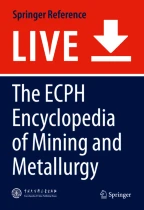
Shaking table separation is the gravity concentration process in which the combined action of the asymmetric reciprocating motion of the table and the water flow on the thin inclined layer separates the mineral particles according to their densities on a wide inclined table. Shaking table separation is suitable for separation of fine particle materials and is widely used for separation of tungsten, tin, tantalum, niobium, and other rare metal and noble metal ores. It is also used for separation of iron ore, manganese ore, and coal.
Shaking table separation (Fig. 1) has a history of over 100 years. In 1890, the first impact shaking table for coal preparation was manufactured in the United States. In 1896–1898, A. Wilfley invented the modern shaking table equipped with an eccentric link mechanism. In 1918, Plat-O invented the shaking table with a cam lever acting as the transmission mechanism. After the Second World War, the fast shaking table driven by eccentric gear was.